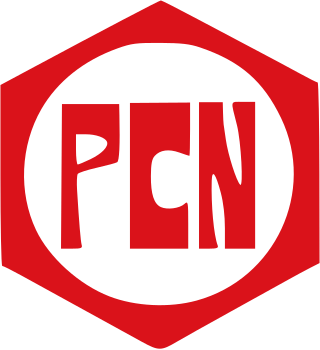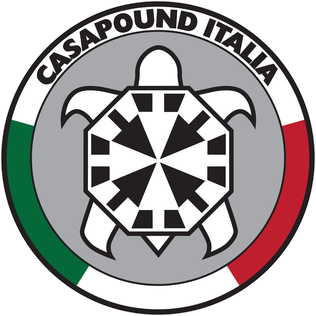Neo-fascism is a post–World War II far-right ideology that includes significant elements of fascism. Neo-fascism usually includes ultranationalism, racial supremacy, populism, authoritarianism, nativism, xenophobia, and anti-immigration sentiment, as well as opposition to liberal democracy, social democracy, parliamentarianism, liberalism, Marxism, capitalism, communism, and socialism. As with classical fascism, it proposes a Third Position as an alternative to market capitalism.
Neo-Nazism comprises the post–World War II militant, social, and political movements that seek to revive and reinstate Nazi ideology. Neo-Nazis employ their ideology to promote hatred and racial supremacy, to attack racial and ethnic minorities, and in some cases to create a fascist state.
Far-right politics, or right-wing extremism, is a spectrum of political thought that tends to be radically conservative, ultra-nationalist, and authoritarian, often also including nativist tendencies. The name derives from the left–right political spectrum, with the "far right" considered further from center than the standard political right.

Jean-François Thiriart, often known as Jean Thiriart, was a Belgian far-right political theorist.
The Third Position is a set of neo-fascist political ideologies that were first described in Western Europe following the Second World War. Developed in the context of the Cold War, it developed its name through the claim that it represented a third position between the capitalism of the Western Bloc and the communism of the Eastern Bloc.

The Piazza Fontana bombing was a terrorist attack that occurred on 12 December 1969 when a bomb exploded at the headquarters of Banca Nazionale dell'Agricoltura in Piazza Fontana in Milan, Italy, killing 17 people and wounding 88. The same afternoon, another bomb exploded in a bank in Rome, and another was found unexploded in the Tomb of the Unknown Soldier. The attack was carried out by the Third Position, neo-fascist paramilitary terrorist group Ordine Nuovo and possibly certain undetermined collaborators.

Jeune Europe was a neo-fascist euro-nationalist movement formed by Jean Thiriart in Belgium. Emile Lecerf, a later editor of the Nouvel Europe Magazine, was one of Thiriart's associates.
Ordine Nuovo was an Italian far right cultural and extra-parliamentary political and paramilitary organization founded by Pino Rauti in 1956. It had been the most important extra-parliamentary neofascist organization of the post-war Italian republic.
This is a list of topics related to racism:

The Parti Communautaire National-Européen (PCN) is a Belgium-based political organisation led by Luc Michel, a former member of the neo-Nazi FANE party. A largely National Bolshevik movement, it also has activists in France.

In Italy, the phrase Years of Lead refers to a period of political violence and social upheaval that lasted from the late 1960s until the late 1980s, marked by a wave of both far-left and far-right incidents of political terrorism and violent clashes.

Franco "Giorgio" Freda is one of the leading neo-Fascist intellectuals of the post-war Italian far-right. He founded a publishing house for neo-Nazi thought, and described himself as an admirer of Hitler. He was convicted but later acquitted for lack of evidence for involvement in the Piazza Fontana bombing. He founded the Fronte Nazionale, which was disbanded by the Italian government in 2000 when Freda and forty-eight other members were found guilty of attempting to re-establish the National Fascist Party.

CasaPound Italia is an Italian neo-fascist movement. It was formerly a political party, born as a network of far-right social centres arising from the occupation of a state-owned building by squatters in the neighborhood of Esquilino in Rome on 26 December 2003. Subsequently, CasaPound spread with other instances of squatting, demonstrations and various initiatives, becoming a political movement.

A far-right social centre is a space inspired by neo-fascist and Third Position ideas, typically in the 21st century.

The Atomwaffen Division, also known as the National Socialist Resistance Front, is an international far-right extremist and neo-Nazi terrorist network. Formed in 2013 and based in the Southern United States, it has since expanded across the United States and it has also expanded into the United Kingdom, Argentina, Canada, Germany, the Baltic states, and other European countries. The group is described as a part of the alt-right by some journalists, but it rejects the label and it is considered extreme even within that movement. It is listed as a hate group by the Southern Poverty Law Center (SPLC), and it is also designated as a terrorist group by multiple governments, including the United Kingdom and Canada.
In the First Italian Republic, after the Second World War, many armed, paramilitary, far-right organizations were active, as well as far-left ones, especially in the Years of Lead.

In Finland, the far right was strongest in 1920–1940 when the Academic Karelia Society, Lapua Movement, Patriotic People's Movement (IKL) and Vientirauha operated in the country and had hundreds of thousands of members. In addition to these dominant far-right and fascist organizations, smaller Nazi parties operated as well.











